The AMD Zen and Ryzen 7 Review: A Deep Dive on 1800X, 1700X and 1700
by Ian Cutress on March 2, 2017 9:00 AM ESTConclusion
The march towards Ryzen has been a long road for AMD. Anyone creating a new CPU microarchitecture deserves credit as designing such a complex thing requires millions of hours of hard graft. Nonetheless, hard graft doesn’t always guarantee success, and AMD’s targets of low power, small area, and high-performance while using x86 instructions was a spectacularly high bar, especially with a large blue incumbent that regularly outspends them in R&D many times over.
Through the initial disclosures on the Zen microarchitecture, one thing was clear when speaking to the senior staff, such as Dr. Lisa Su, Mark Papermaster, Jim Anderson, Mike Clark, Sam Naffziger and others: that quiet confidence an engineer gets when they know their product is not only good but competitive. The PR campaign up until this point of launch has been managed (we assume) such that the trickle of information comes down the pipe and keeps people on the edge of their seat. Given the interest in Ryzen, it has worked.
Ryzen is AMD’s first foray into CPUs on 14nm, and using FinFETs, as well as a new microarchitecture and pulling in optimization methods from previous products such as Excavator/Carrizo and the GPU line. If we were talking tick-tock strategy, such as Intel’s process over the last decade, this is both a tick and a tock in one. Ryzen is the first part of that strategy, on the desktop processors first, with server parts coming out in Q2 and Notebook APUs in 2H17. One of the main concerns with AMD is typically the ability to execute – get enough good parts out on time and with sufficient performance to merit their launch. As Dr. Su said in our interview, it’s one big hurdle but there are many to come.
| AMD Ryzen 7 SKUs | ||||||
| Cores/ Threads |
Base/ Turbo |
L3 | TDP | Cost | Launch Date | |
| Ryzen 7 1800X | 8/16 | 3.6/4.0 | 16 MB | 95 W | $499 | 3/2/2017 |
| Ryzen 7 1700X | 8/16 | 3.4/3.8 | 16 MB | 95 W | $399 | 3/2/2017 |
| Ryzen 7 1700 | 8/16 | 3.0/3.7 | 16 MB | 65 W | $329 | 3/2/2017 |
Today’s launch of three CPUs, part of the Ryzen 7 family, will be followed by Ryzen 5 in Q2 and Ryzen 3 later in the year. Ryzen 7 uses a single eight-core die, and uses simultaneous multi-threading (SMT) to provide sixteen threads altogether, up to 4.0 GHz on the top Ryzen 7 1800X chip for $499. Officially AMD is positioning the 1800X as a direct competitor to Intel’s i7-6900K, an 8-core processor with hyperthreading that costs over $1000. In our benchmarks, it’s been clear that this battle goes toe-to-toe.
Analyzing the Results
In the brief time we had before getting a sample and this review, we were able to run our new benchmark suite on twelve different Intel CPUs, as well as AMD’s former APU crown holder, the A10-7890K. Throughout the discussion about Ryzen, AMD was advertising a 40%+ gain in raw performance per clock over their previous generations, which was then upped to 52% when the CPUs were actually announced. Back of the envelope calculations put Ryzen at the level of the high-end desktop Broadwell CPUs or just about, which means it would be a case of pure frequency. That being said, Intel is already running CPUs two generations ahead on its mainstream platform, such as the Kaby-Lake based i7-7700K, so it’s going to be an interesting analysis.
Multi-Threaded Tests
First up, AMD’s strength in our testing was clearly in the multithreaded benchmarks. Given the microarchitectures of AMD’s and Intel’s high-performance x86 cores are somewhat similar, for the most part there’s a similar performance window. Intel’s design is slightly wider and has a more integrated cache hierarchy, meaning it manages to win out on ‘edge cases’ that might be a result of bad code. As one might expect, it takes a lot of R&D to cater for particular edge cases.
But as a workstation-based core design, the Zen microarchitecture pulls no punches. As long as the software doesn’t need strenuous AVX code, and manages its memory carefully (such as false sharing), the performance of Ryzen in conventional multi-threaded CPU environments means AMD is back in the game. This is going to be beneficial for the Zen microarchitecture when we see it applied into server environments, especially those that require virtualization.
Single Threaded Tests
Since the launch of Bulldozer, AMD has always been a step behind on single-threaded performance. ST performance is a holy-grail of x86 core design, but often requires significantly advanced features that can potentially burn extra power to get there. AMD’s message on this, even in our interview with Dr. Su, is that AMD has the ability to innovate. This is why AMD promotes features such as SenseMI for their new advanced pre-fetch algorithms, why implementing a micro-op cache into the core was a big thing, and how having double the L2 cache over Intel’s comparable parts were important to the story. Nonetheless, AMD hammered down that a 40%+ IPC gain into its narrative, which then folded into a 52% gain at launch. We’ll take a deeper look into this in a separate review, but our single threaded results show that AMD is back in the fight.
Most of the data points in this graph come from Intel Kaby Lake processors at various frequencies, but the important thing here is that the Ryzen parts are at least in the mix, sitting above the other eight core parts on the far right of the graph. Also, the jump from the A10 up to the 1700 is a big generational jump, let alone considering the 1800X.
Overall Performance
Putting these two elements into the same graph gives the following:
By this measure, for overall performance, it’s clear the Core i7-7700K is still better in price/performance. However, AMD would argue that the competition for the Ryzen 7 parts is on the right, with the i7-6900K and i7-5960X. In our CPU-based results, AMD wins this performance per dollar hands down.
Some Caveats
Since testing this review, and waiting a few days to even write the conclusion, there has been much going on about ways in which AMD’s performance is perhaps being neutered. This list includes discussions around:
- Windows 10 RTC disliking 0.25x multipliers, causing timing issues,
- Software not reading L3 properly (thinking each core has 8MB of L3, rather than 2MB/core),
- Latency within a CCX being regular, but across CCX boundaries having limited bandwidth,
- Static partitioning methods being used shows performance gains when SMT is disabled,
- Ryzen showing performance gains with faster memory, more so than expected,
- Gaming Performance, particularly towards 240 Hz gaming, is being questioned,
- Microsoft’s scheduler not understanding the different CCX core-to-core latencies,
- Windows not scheduling threads within a CCX before moving onto the next CCX,
- Some motherboards having difficulty with DRAM compatibility,
- Performance related EFIs being highly regularly near weekly since two weeks before launch.
A number of these we are already taking steps to measure. Some of the fixes to these issues come from Microsoft’s corner, and we are already told that both AMD and Microsoft are underway to implement scheduling routines to fix these. Other elements will be AMD focused: working with software companies to ensure that after a decade of programming for the other main x86 microarchitecture, it’s a small step to also consider the Zen platform.
At this point, we’re unsure at what level some of these might be default design issues with Zen. The issue of single-thread performance increasing when SMT is disabled (we’ve done some pre-testing, up to 6% in ST) is clearly related to the design of the core, with static partitioning vs competitive partitioning of certain parts of the design. The CCX latency and detection is one that certainly needs further investigation.
The future according to Senior Fellow Mike Clark, one of the principle engineers on the Zen microarchitecture, is that AMD knows where the easy gains are for their next generation product (codenamed Zen 2), and they're already working through the list. A question is then if Intel continues at 5% performance gains clock for clock each year, can AMD make 5-15% and close the gap?
The Silver Lining
It is relevant to point out that Intel is on its 7th Generation of Core microarchitecture. Sure, it looks significantly different when it was designed, but software vendors have had seven generations to optimize for it. Coming in and breaking the incumbent’s stranglehold is difficult, when every software vendor knows that design in and out. While AMD’s design looks similar to Intel, there are nuances which programmers might not have expected, and so it might be a good couple of years before the programming guides have made their way through into production software.
But,
When we look at the CPU benchmarks as part of this review, which have a strong range in algorithm difficulty and dependency, AMD still does well. There’s no getting around that AMD has a strong workstation core design on their hands. This bodes well for users who need compute at a lower cost, especially when you can pick up an eight-core Ryzen 7 at half the cost of the competition.
This makes the server story for AMD, under Naples, much more interesting.
AnandTech Recommended Award
For Performance/Price on a Workstation CPU


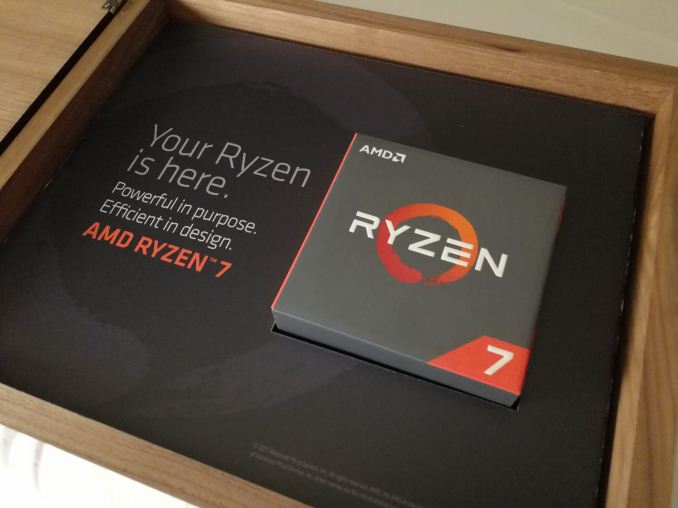
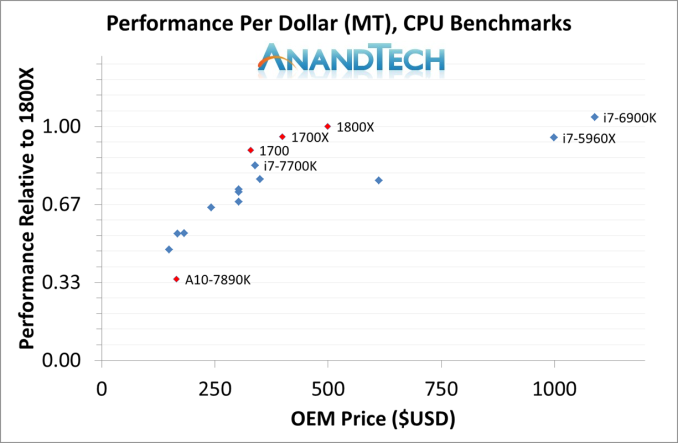
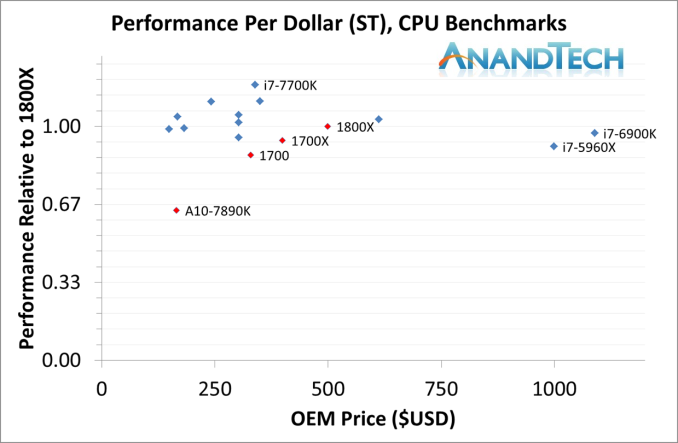
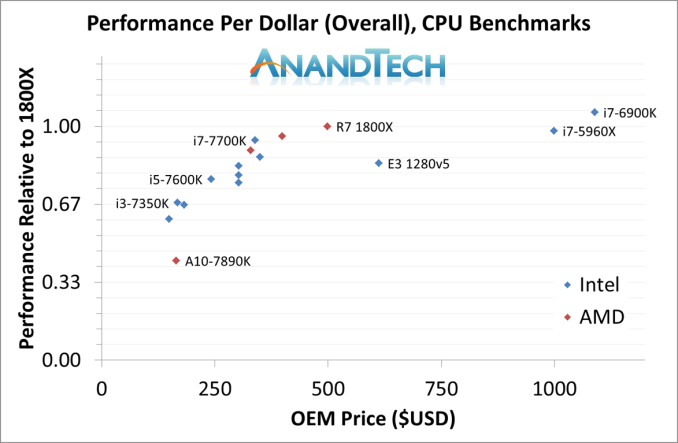
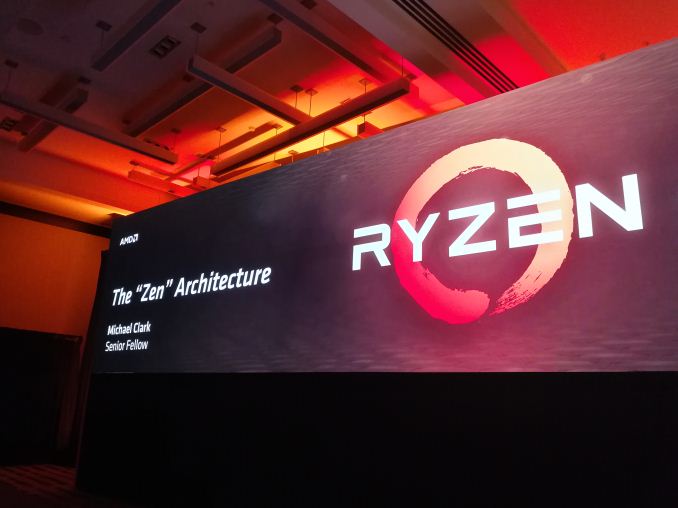










574 Comments
View All Comments
bobsta22 - Saturday, March 4, 2017 - link
Office with 20 PCs - all developers - loads of VMs and containers.All the PCs are due a CPU/Gfx refresh, but ITX mobos required.
Cant wait tbh. This is a game changer.
prisonerX - Saturday, March 4, 2017 - link
What if they come out with a 16 core line next year!bobsta22 - Saturday, March 4, 2017 - link
What?lilmoe - Tuesday, March 7, 2017 - link
It really is. As a freelance developer, I can't wait.ericgl21 - Saturday, March 4, 2017 - link
For me, the more important thing to see from AMD is if they can come up with a chip that can beat the mobile Core i7-7820HQ (4c/8t no ECC) & the Xeon E3-1575M v5 (4c/8t with ECC), for less money.And the number of PCIe gen3 lanes is very important, especially with the rise of M.2 NVMe storage sticks.
cmagic - Sunday, March 5, 2017 - link
Will anandtech review Ryzen in gaming? I would really like Anandtech view, since I don't really trust other sites especially those "entertainment" sites. Want to see how Anandtech dive into its main cause.Tchamber - Sunday, March 5, 2017 - link
@cmagicPage 15
2017 GPU
The bad news for our Ryzen review is that our new 2017 GPU testing stack not yet complete. We recieved our Ryzen CPU samples on February 21st, and tested in the hotel at the event for 6hr before flying back to Europe.
I just ordered my 1700X, I plan to keep it for at least 5 years, as my needs don't change much. My current Intel 6 core is coming up on 7 years old now. I like to buy high end and use it a long time.
Lazlo Panaflex - Monday, March 6, 2017 - link
Same here...probably gonna grab a 1700 at some point and put this here i5-2500 non-k in the kids computer.asH98 - Sunday, March 5, 2017 - link
'''The BIG QUESTION is WHY are the HEDT benchmarks (professional ie Blender) fairer than gaming benchmarks??Bottom line is that CUTTING-EDGE CODING is happening NOW in AI, HPC, data, and AV/AR, game coders because of $$$ are the last to change or learn unless forced (great for NVidia Intel) so most of the game coding is stuck in yesteryear- Bethesda will be the test bed for game coders to move forward
Hence the difference in game benchmarks vs 'professional' (HEDT) benchmarks. Game coders can get stuck using yesterday's code without repercussions and consequences as long as old hardware dominates and there are no incentives to change or learn new skills. The same Cant happen in the Professional area where speed is tantamount to performance and $$$
TheJian - Sunday, March 5, 2017 - link
I hope you're going to test a dozen games at 1080p where most of us run for article #2 and the GAMING article should come in a week not 1/2 year later like 1080/1070 gtx reviews...LOL. As this article just seems like AMD told you "guys, please don't run any games so we can sell some chips to suckers before they figure out games suck". And you listened. No point in testing 1440p or 4k for CPU, and 95% of us run 1920x1200 and BELOW so you should be testing your games there for a CPU test.The fact they are talking Zen2 instead of fixing Zen1 kind of makes me think most of the gaming is NOT going to be fixable.
http://www.legitreviews.com/amd-ryzen-7-1800x-1700...
149fps for 7700 in theif vs. 108 for 1800x? JEEZ. GTA5 again, 163 to 138. Deus ex MD 127 to 103. These are massive losses to Intel's chip and Deus was clearly gpu bound as many of Intel's chips hit the same 127fps including my old 4790k :( OUCH AMD.
https://www.guru3d.com/articles_pages/amd_ryzen_7_...
Tombraider same 7700k vs. 1800x 132fps to 114 (never mind 6850 scoring 140fps). This will probably get worse as we move to 1080ti, vega, nvidia refresh for xmas, Volta, 10nm etc. If you were using a faster gpu the cpus will separate even more especially if people are mostly gaming at 1080p. Even if many move to 1440p, that maybe fixes some games (tombraider is one with 1080 regular that hits a wall at 90fps), but again goes back to major losses as we move to 10nm etc. We get 10nm chips for mobile now and gpus probably next year at 12nm (real? fake 12nm? Either way) and might squeak into 2017 (volta, TSMC). 10nm gpus will likely come 2018 at the latest. Those gpus will make 1440p look like 1080p today surely and cpus will again spread out (and no, we won't all be running 4k then...LOL). You could see cpus smaller than 10nm BEFORE you upgrade your cpu again if you buy this year. That could get pretty ugly if the benchmarks around the web for gaming are not going to improve. One more point you'll likely be looking at GDDR6 (16Gbps probably) for vid cards allowing them to possibly stretch their legs even more if needed. Again, all not good for a gamer here IMHO.
“But Senior Engineer Mike Clark says he knows where the easy gains are for Zen 2, and they're already working through the list”
So maybe no fix in sight for Zen1? Just excuses like "run higher res, and code right guys"...I hope that isn't the best they've got. I could go on about games, but most should get the point. I was going to buy ryzen purely for Handbrake, but I'll need to see motherboard improvements and at least some movement on gaming VERY soon.
One more ouch statement from pcper.
https://www.pcper.com/news/Processors/AMD-responds...
"For buyers today that are gaming at 1080p, the situation is likely to remain as we have presented it going forward."
So they don't think a fix is coming based on AMD info and as noted as gpus get much faster (along with their memory speeds) expect 1440p to look like today's 1080p benchmarks at least to some extent.
The board part is of major interest to me, so I can wait a bit and also see Intel's response. So AMD has be hanging for a bit here, but not for too long. I do like the pro side of these though (handbrake especially, just not quite enough).